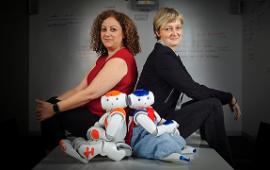Swinburne team researching the use of humanoid robotics in education

In Summary
This article originally featured in Swinburne’s Venture magazine
As interactive, 3D models that reward students’ coding eff orts with a physical response, robots have proved to be excellent teaching aides.
Swinburne senior lecturer and robotics expert Therese Keane has another reason for choosing NAO humanoid robots as teaching aides though: they’re cute.
“We also work with LEGO robots – you still program them and they move, but they don’t have that cuteness factor, or arms and legs that move like a human,” she says. “With humanoid robots, you don’t have to build anything; you start programming and get right into it.”
Dr Keane, who is Deputy Chair of Education at Swinburne, is part of a team researching the use of humanoid robotics in education. The team has been tracking the success of two humanoid robots being shared by independent schools in South Australia.
“We’ve been looking at how each school integrates them into the curriculum, how teachers work with them and how the students interact,” Dr Keane says.
“The students have wanted to connect with the robot, treat it as a friend or classmate, because these humanoid robots change eye colour, they move their arms and legs, they stand like a human, they sit like a human.”
Students as young as four draw storyboards to work out what they want the robots to do. A rural school with a significant percentage of indigenous students has used the robots to teach traditional language skills.
“Aboriginal and non-Aboriginal students worked with humanoid robots to develop their programming skills and their understanding of the Narungga language and culture,” Dr Keane says.
“By looking at how the robots have been used in different schools, we’ve come up with a model called the 4plus4 model. This was developed by investigating how humanoid robots integrated into the classroom and the common themes that emerged: curiosity, challenge, collaboration, communication, critical thinking, creative thinking, computational thinking and coding.”
Dr Keane would love to see the humanoid robots rolled out to all states and schools, but funding is an issue.
“We’d like to see if there are more affordable technologies that might provide similar learning outcomes,” she says.
Dr Keane is the Victorian Tournament Director for the FIRST (For Inspiration and Recognition of Science and Technology) LEGO League, which Swinburne hosts each November, attracting more than 300 students.
She is also a lead mentor with the RoboCats – an all-girl team of secondary school students who built an industrial robot for the international FIRST Robotics Competition.
The RoboCats took its 50-kilogram creation to compete against about 40 other teams in Sydney and won the 2017 South Pacific Championships. Dr Keane was awarded the Woodie Flowers Award for mentorship and the team will compete in Houston, Texas, later this year.
“Swinburne’s Innovation Precinct and the Faculty of Health Arts and Design and Faculty of Science, Technology and Engineering are major sponsors of the team, alongside sponsors such as Ford, BAE Systems, Invetech, Boeing and Salesforce,” Dr Keane says.
Extending the range of robotics teaching is a goal close to Dr Keane’s heart. But, as an innovator in the field, she is wary of moving too quickly and oversimplifying the topic.
“Recently I’ve been appointed chair of the ICT Educational Committee with the Australian Computer Society. We’re bringing out a program to help teachers because some are struggling to teach digital technology.
“Programming is a skill, just like literacy and numeracy; students need it to stay relevant in a knowledge economy,” Dr Keane says.

